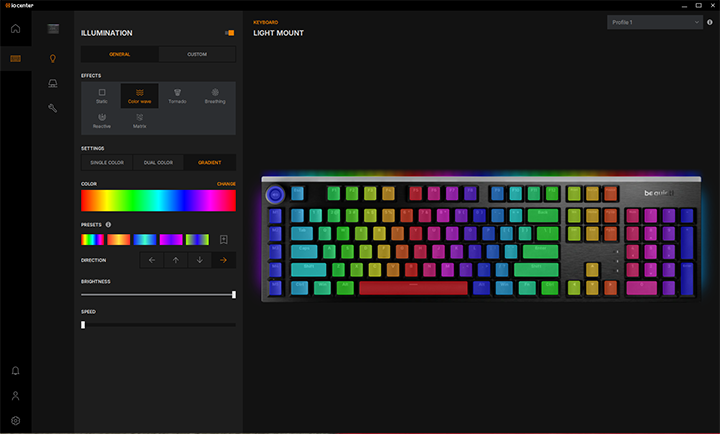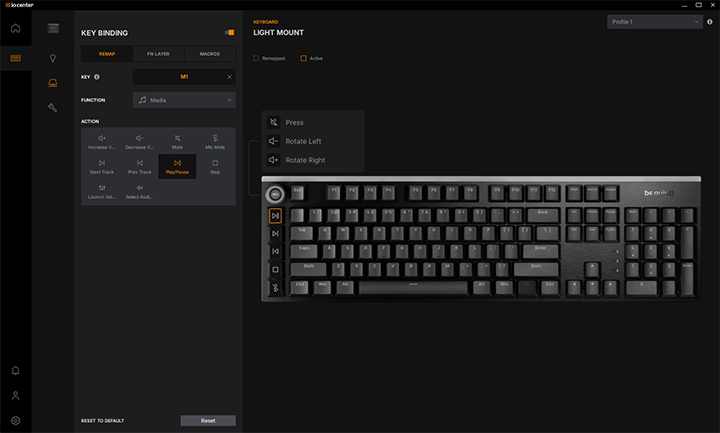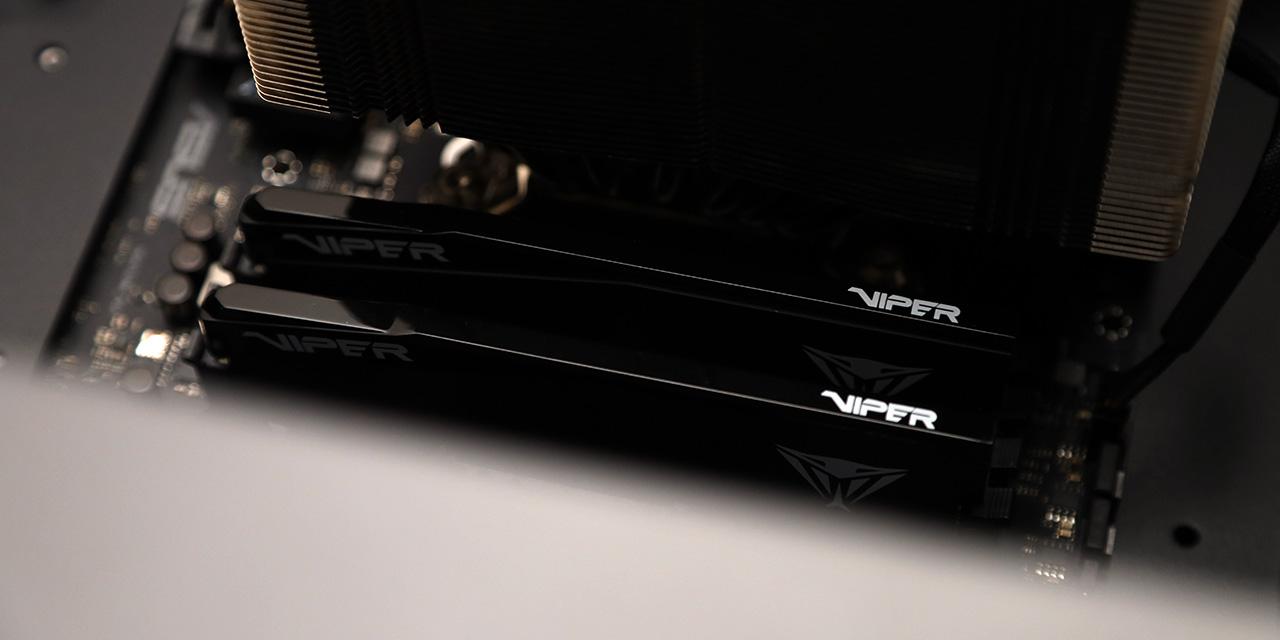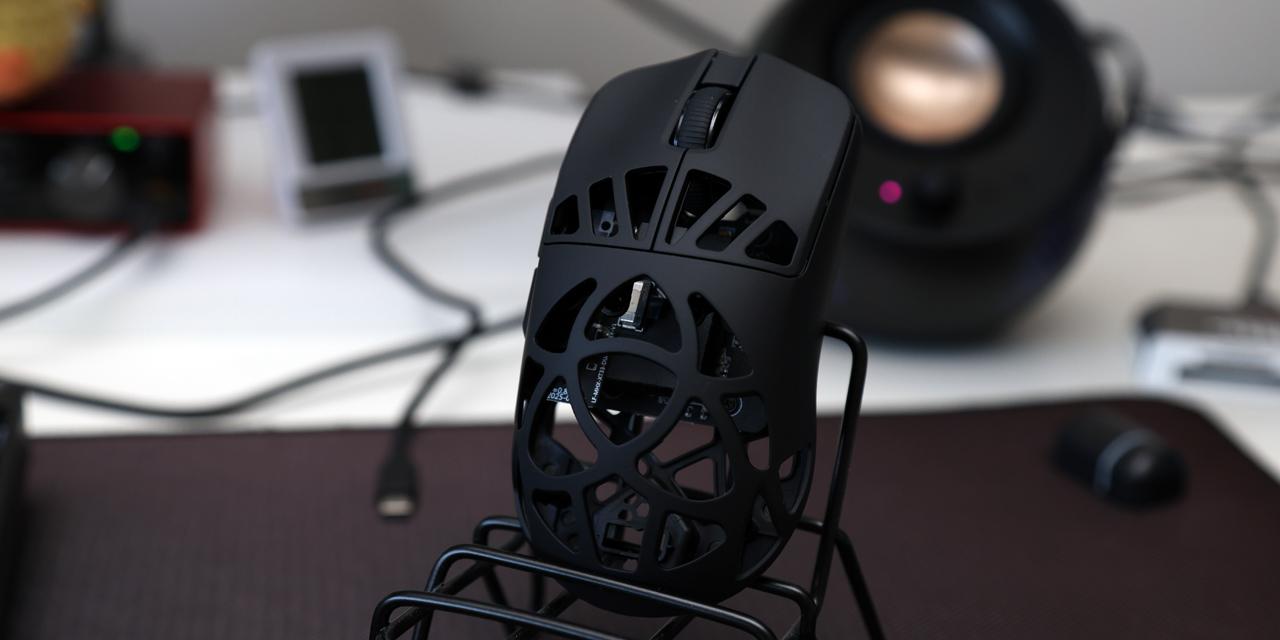Page 2 - A Closer Look - Hardware and Software

The be quiet! Light Mount Silent Linear is only available in black, but there are many options for the keyboard layout standard. The choices are DE ISO, US ANSI, UK ISO, and FR ISO. The top plate is made with brushed aluminum, which gives the keyboard a nice textured reflective finish. The keyboard is a perfect rectangle with rounded corners. The black matte keycaps provide a subtle contrast to the reflective black aluminum. On the contrary, the low bezel design reveals the translucent switches, which provide a clear contrast with the rest of the keyboard. At the top right of the keyboard, the be quiet! is labeled in a smooth, reflective black font. The aluminum knob at the top left has discrete steps, where each turn snaps in place like a mouse scroll wheel. be quiet! refers to this knob as the "3D Media Wheel". The keyboard also comes with a wrist rest that can be attached to the keyboard through the internal magnets. I am unsure what the material is, but it is very comfortable and smooth. I find the overall design of the keyboard to be simple and elegant. However, when I first unboxed the keyboard, I noticed a lot of grease stains scattered throughout the top plate. I was able to wipe some of it off with a decent amount of effort using a microfiber cloth, but some stains were more stubborn.
The be quiet! Light Mount Silent Linear is a full-size keyboard with the addition of the knob and macro keys. This is reflected in its dimensions, which measure 212mm in length, 461mm in width, and 44mm in height with the wrist rest and 132mm in length, 461mm in width, and 44mm in height without it. The weight of the keyboard without the wrist rest is 0.96kg, which is reasonable considering the size and the aluminum top plate. The metal top plate also provides a solid structure for the keyboard. There is nearly no flex when pushing directly on the top plate as well as the keys. I was able to get a slight flex by performing a twisting motion, but overall, the keyboard is very sturdy.

The layout version of the be quiet! Light Mount Silent Linear we have is US ANSI. There is a total of 110 keys, including the clickable knob and five macro keys. The extra keys offset the keys to the right, but otherwise, everything accurately reflects the US ANSI layout. Even though the layout is standard, it did take me some time to adjust to the offset.

There are a few default secondary function hotkeys on the be quiet! Light Mount Silent Linear. While holding the Fn key, the right and left arrow keys cycle through the ARGB patterns, while the up and down arrow keys adjust the brightness. Pressing the Fn key and the pause key will enter game mode, which by default disables the key combinations Shift + Tab, Alt + F4, Alt + Tab, and Windows key. The keyboard can be reset to factory default by holding the Fn and R keys for five seconds. There are no default secondary functions for the numbered function keys.
Turning the knob will adjust the system volume, while pressing it will mute or unmute the sound. By default, the M1 key plays or pauses media, M2 key plays the next track, M3 key plays the previous track, M4 key stops media playback, and the M5 key mutes or unmutes the microphone.

The back side of the be quiet! Light Mount Silent Linear is made of ABS plastic. There are five rubber pieces distributed near the edges to ensure the keyboard does not slip while typing. There are two feet on each top corner, which allow the typing angle to be adjusted between three heights. At the center, there are grooves to create a stripe pattern. At both ends of the pattern, there are ARGB LED light strips. The 2m USB Type-A to USB Type-C can be connected to the keyboard through the USB Type-C port found on the top side edge of the keyboard. The poll rate of the keyboard is 1000Hz with full N-key rollover.

The sound created when typing on the be quiet! Light Mount Silent Linear is rather unique. The movement of the linear switch creates a sound similar to the soft crumbling noise of foam. Once the key reaches the bottom, there is a soft, muted thump. The larger keys create a deeper bottoming out sound than the smaller ones, with the space bar being the deepest. There is also no noticeable case pinging as I was typing. The overall feel was smooth, but I would prefer some flex to cushion the typing experience. The biggest issue I have with the sound is the stem rattle coming from the switches. With every keystroke, I can clearly hear a medium-pitched rattle sound during both key press and release. On the be quiet! website, they mention in multiple places that this keyboard is supposed to be silent, but with the rattling sound, it is definitely not. By pressing the keys without lifting my fingers, I was able to listen to the intended sound, which I found to be quite satisfying. However, the quietness of the keys bottoming out only made the raw stem rattling sound more obvious. As a result, I find the overall sound profile to be slightly unpleasant.

As for the ARGB LED lighting of the be quiet! Light Mount Silent Linear, this is where it shines. The brightness level is quite good. The labels on the double-shot PBT keycaps are translucent, which enhances the ARGB experience. The exposed switches extend the amount of light on the keyboard. There is also the long ARGB light strip at the top, which has forty-five individually controllable light zones. The two ARGB LED light strips on the back of the keyboard each have five individually controllable light zones. All keys have their own ARGB LED as well, and they are all well-diffused with no noticeable bright spots. As a colorful lights enjoyer, I am quite impressed with the ARGB LED lighting on this keyboard. The only minor complaint I have is the under glow created by the bottom ARGB strips is not noticeable enough.

The IO Center software to control the be quiet! Light Mount Silent Linear can be found on the manufacturer's website. There are three pages, with the first being Illumination. While there are only six preset ARGB patterns, there is an abundant amount of customization options. Most patterns allow for a dual color combination or a rainbow gradient, as well as the adjustment of speed and brightness. In the custom tab, the software allows seven pattern layers. Within each layer, you can select any number of keys or ARGB lighting zones and set a pattern. This could allow for some very creative color patterns, which I appreciate.

In the Key binding page, the keys can be remapped on the Remap tab to a variety of functions. There are ten categories of functions to choose from, which are standard key, media, mouse, open file or start application, open folder, open URL, Windows shortcut, profile, backlight, and macro. Macros can be set in the Macros tab. Fn Layer allows you to set the secondary functions of keys. However, secondary functions for the keys R and Pause are reserved and cannot be remapped. The last page in the software is Product Settings, where you can update firmware, reset the keyboard to factory settings, and toggle what key combinations are turned off when game mode is active. The five key combinations for game mode are preset, so no new ones can be added.
Page Index
1. Introduction, Packaging, Specifications
2. A Closer Look - Hardware and Software
3. A Closer Look - Disassembly and Internals
4. Conclusion





